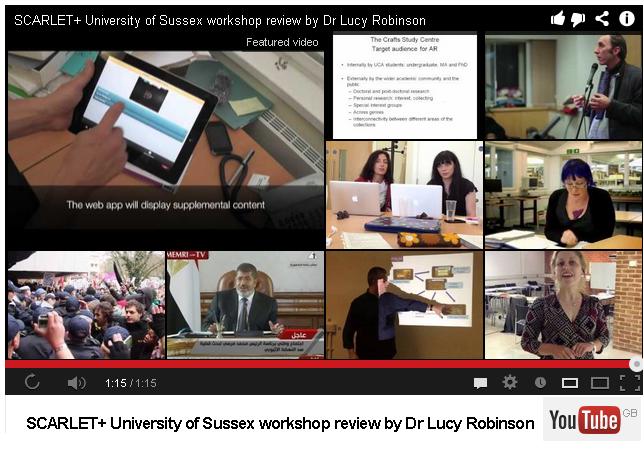Augmented Reality in Education: The SCARLET+ Experience
Laura Skilton, Matt Ramirez, Guyda Armstrong, Rose Lock, Jean Vacher and Marie-Therese Gramstadt describe augmented reality in education case studies from the University of Sussex and the University for the Creative Arts.
Augmented reality, a capability that has been around for decades, is shifting from what was once seen as a gimmick to a bona fide game-changer. [1]
Augmented Reality (AR) has been listed in the Horizon Reports, key predictors of the potential impact of new technology on education. The 2011 Report [1] sparked the idea for an innovative project - SCARLET: Special Collections using Augmented Reality to Enhance Learning and Teaching.
The Jisc-funded SCARLET Project was led by the Learning and Teaching team at Mimas [2], a national centre of expertise at The University of Manchester. A mixed team was pulled together dedicated to enhancing the student experience through the application of technology. This team comprised librarians, academics, learning technologists and students. The team went on to win the 2nd prize for the ALT Learning Technologist of the Year team award [3]. Critical to its success was the embedding of the technology into teaching practices from the outset, as well as student evaluations. Follow-on funding was made available for a second project, SCARLET+, which aimed to transfer and embed all the skills, knowledge and experience gained at The University of Manchester to the University of Sussex and the Craft Study Centre at the University for the Creative Arts.
To date, the use of AR within education has mainly focused on its marketing potential, echoing perhaps the use of AR in advertising and at high-profile events, such as the London 2012 Olympics. The SCARLET and SCARLET+ Projects are enabling us to understand better the value of AR to education, and to special collections materials and objects. The significant interest from the library and learning communities indicates the huge potential for developing this work further.
What Is Augmented Reality (AR)?
AR can be defined as the process where computer graphics are layered on the real world through a camera controlled by the user. It may recognise an object or image using a visual search or a point of interest (POI) from GPS co-ordinates such as a building or landmark to provide contextual information. Although AR can be implemented on a desktop computer, it has a greater potential when used on portable devices such as a smartphone or tablet.
Figure 1: SCARLET Augmented Reality User Journey.
© Mimas, University of Manchester, video on YouTube
From prototypes in the early 1990s, AR has become more mainstream; recent technical advances and the proliferation of smartphones have made its use more viable. Early examples of AR can be seen in marketing and industry, but it is increasingly being used in other areas such as education.
On a technical level, there are broadly two categories of AR: marker-based, and marker-less systems. Marker-based systems use physical patterns or images to act as reference points for computer graphics to be overlaid. In contrast, marker-less systems use location-based data through inbuilt phone sensors such as GPS, to verify the user’s position in the physical world and query datasets to influence what will be displayed on screen.
The SCARLET Project
The SCARLET Project (June 2011- May 2012) addressed one of the main obstacles with the use of special collections in learning and teaching: the fact that students are required to consult archives, manuscripts and rare books within the controlled conditions of reading rooms, isolated from much of the secondary supporting materials and a growing mass of related digital assets. This is an unfamiliar experience for students who are accustomed to an information-rich wireless world, and it is therefore perceived to be a barrier to their use of special collections. AR can enable students to experience simultaneously the magic of original primary materials, such as an early printed book in the library, whilst enhancing the learning experience by surrounding the book with digitised content, for example, images, texts, online learning resources, and information on related objects.
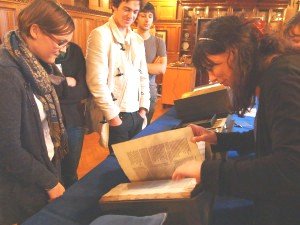
Figure 2: Dr Guyda Armstrong shows her students a selection of early printed editions of Dante.
© Mimas, University of Manchester
One of the project’s key findings was that the two academics who trialled the use of AR in their classes, received different responses from their students. Where AR can enhance the learning experience by providing additional in-context information, this seems to meet with most approval and provides most benefit for the students. Simply attaching existing resources to an object is not enough. AR is more effective when enhancing physical objects, such as manuscripts, papyri and books, rather than signposting to Web-based support materials, even if they are mobile-specific.
By taking advantage of the team’s diverse academic expertise, learning and teaching was embedded at the heart of the project, ensuring that the focus remained on the student experience and not the technology. Student evaluation was critical to the success of the project, with their learning experience feeding into an iterative development of the application created [4].
SCARLET+
Following on immediately after the Jisc-funded SCARLET Project, SCARLET+ (June 2012 – April 2013) built upon its successes in order to pilot AR with two other UK universities [5]. Working with staff from Special Collections at the University of Sussex [6] and the Crafts Study Centre at the University for the Creative Arts [7], the project’s aim was to embed both the knowledge and skills needed to use AR, and to test and refine the SCARLET toolkit [8].
Figure 3: AR content shown over an image of the papyri fragment of the Gospel of St. John [9].
© Mimas, University of Manchester. Photo: Marie-Therese Gramstadt
The SCARLET+ Project took the lessons learnt from SCARLET, together with Mimas’s new understanding of the knowledge, skills and barriers to developing AR, to other institutions and different types of collections - mass observation and 20th-century crafts. This project has further built Mimas’s understanding of the application of AR in education, and transferred knowledge across the wider community. Crucial to its success was ensuring that, as with SCARLET, a mixed team approach was adopted. This has ensured that the AR developed made an impact on learning and teaching as well as enabling AR skills to spread across the institutions.
The following two sections present case studies of work in progress at the University of Sussex and the University for the Creative Arts. It is worth noting these sections cover some of the implications for future AR development within the education sector.
Special Collections at the University of Sussex
The SCARLET+ Project at the University of Sussex has worked with the Mass Observation (MO) collections [10] held by Special Collections [6], with particular focus on material digitised as part of the Jisc-funded Observing the 1980s Project [11].
Mass Observation was established in 1937 as a written social observation project in which people around the country were recruited to become what Mass Observation’s founders described as ‘the cameras with which we are trying to photograph contemporary life’. The move in the 1970s of the Mass Observation Archive (MOA) material to Sussex inspired the establishment of a second phase of collecting which began in 1981, named the Mass Observation Project (MOP) [12].
Mass Observation provides researchers with a vast collection of qualitative data on many subject themes, and over the past ten years the Archive has been involved in various projects to increase their accessibility to researchers and anyone wishing to use it to teach at all levels. The Observing the 1980s material is being used to create a number of Open Educational Resources (OERs) that will be embedded in a second-year History course run at Sussex by Dr. Lucy Robinson.
Towards an Augmented Reality Application for Sussex
The first step towards creating the SCARLET+ application was a workshop in July 2012 [13] during which Laura Skilton, Matt Ramirez and Dr. Guyda Armstrong introduced potential applications of AR in learning and teaching. This pivotal workshop inspired and supported Sussex and facilitated discussions of what actually to build. Represented at the workshop were a wide range of Sussex staff members including Stuart Lamour, an e-learning developer with experience in AR; Dr. John Davies, an educational developer; Dr. Lucy Robinson, Sussex history lecturer and SCARLET+’s academic lead; Jill Kirby, project manager for Observing the 1980s, as well as a variety of Special Collections and Library staff. Having input at this initial brainstorming stage from people with such different skills and experience was invaluable as it widened the project’s concept of what was possible both in learning and teaching and with the AR technology itself.
Figure 4: SCARLET+ University of Sussex workshop review by Dr Lucy Robinson.
© Mimas, University of Manchester, video on YouTube
The original idea was to make use of the vast amount of copyright-cleared material digitised for Observing the 1980s as the core of the application, but the project team quickly came to realise that simply replicating this resource did not make full use of AR’s potential. Moreover, since AR is accessed through a device that can already access the Observing the 1980s Web-based content it seemed rather pointless. Eager to make sure that AR added something unique to Dr. Robinson’s teaching, the idea of using the application to present additional voices and their attitudes towards MOP was suggested. This fitted the bill perfectly.
The SCARLET+ application at Sussex presents three Mass Observers through their digitised writings, the MOA Assistant, Jessica Scantlebury and a student historian who has used MOP in her research. Jessica and the student historian were filmed talking about their experience of and feelings about Mass Observation. One of the biggest bonuses of this structure, which concentrates on the interpretation of archival material, is that it could be applied to any discipline and any collection. For example an application could be created that uses part of Special Collections’ Bloomsbury papers to present disparate voices from an archivist, to a literature fan to Virginia Woolf herself.
Minded to include a further set of voices, the project team also investigated the possibility of students using the application and adding their own comments; thereby creating a living, growing resource that is somewhat akin to MO itself. Unfortunately this was not a simple function to develop, so it was decided that it could not be part of the original application but could be something to add in the future.
Ups and Downs of Creating an AR Application
Rose Lock, Senior Archive Assistant and SCARLET+ Project Officer, University of Sussex comments:
The AR applications I looked at initially had such an impressive ‘wow’ factor that I was concerned that I wouldn’t be able to learn how to construct something that looked so complicated and technical.
Rose went on to experiment with a range of different programmes designed to create AR applications, but found them either very simple to use - but extremely limited in their capabilities, or wonderfully flexible - but which erected a technological ‘brick wall’.
The SCARLET+ Project then brought the Project Officer from University of Sussex and the Educational Technologist from University for the Creative Arts together in Manchester for a technical workshop. This made an enormous difference for both institutional partners and was a real turning-point in the AR technical development for the project. Both the Project Officer and Educational Technologist found that having a face-to-face training session with Matt Ramirez, the SCARLET+ multimedia content developer was invaluable. This was particularly necessary for getting to grips with AR, as there were few how-to guides available and they were normally designed for commercial and technical developers. By providing carefully explained and commented lines of code, and by demonstrating what happens when different sections are changed, Matt provided the project officers with both the framework and the confidence to create their own AR applications.
The process of creating University of Sussex’s AR application has been a roller-coaster of triumphs and tribulations. Some of the problems with AR development can be quite subtle to solve; for example, for a long time the device would not recognise the trigger image and so this held up development with the rest of the application. The breakthrough came when Matt suggested creating the tracking file for the trigger image through the Mozilla Firefox Web browser (as opposed to Internet Explorer). This apparently simple solution worked and enabled Rose to start getting into the nitty-gritty of how changing code changes the application, learning about linking, and coming up with the first rough version.
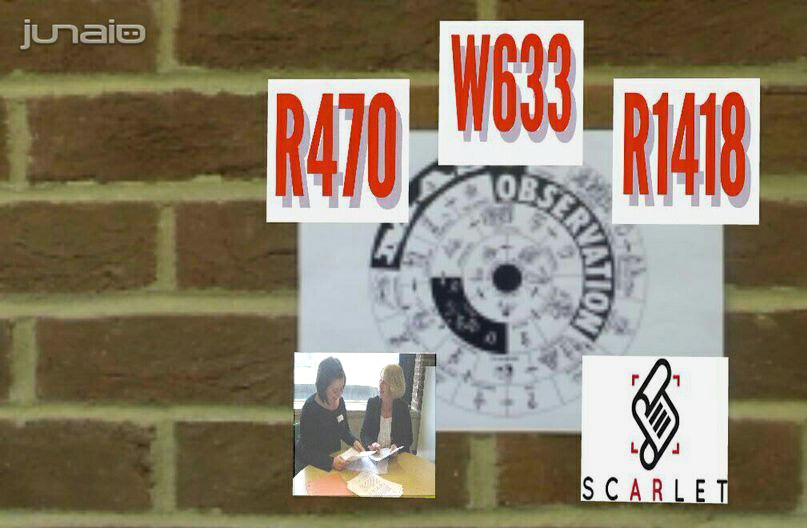
Figure 5: AR content displaying on a tablet device held in front of the trigger image with a physical wall.
© Special Collections, University of Sussex
Once a basic working AR application was created, Special Collections staff were invited to a session to play with it. This was intended to keep them up to date with project progress, give them a window into the processes involved in creating an AR application, and to invite them to provide feedback. As the whole idea of SCARLET+ is to embed the skills into Special Collections, these sessions have been an essential part of the project as they help the rest of the department to see how an application is made. It was important to hold the sessions using half-built, slightly shoddy-looking first-draft AR applications, rather than have no contact or feedback and then suddenly produce a finished app.
‘What has it got in its Pockets-es?’ Introducing AR to Students
As the staff sessions have always been successful, mostly due to the enthusiasm of the staff, it was therefore a bit of a shock when the first attempt to introduce the newly created Voices In Your Pocket application to University of Sussex students was less than a roaring success. At the end of November 2013, an archive box was packed with three iPads, print-outs of the trigger image, and basic AR how-to-instructions – to be used in an MA History seminar on the 1980s.
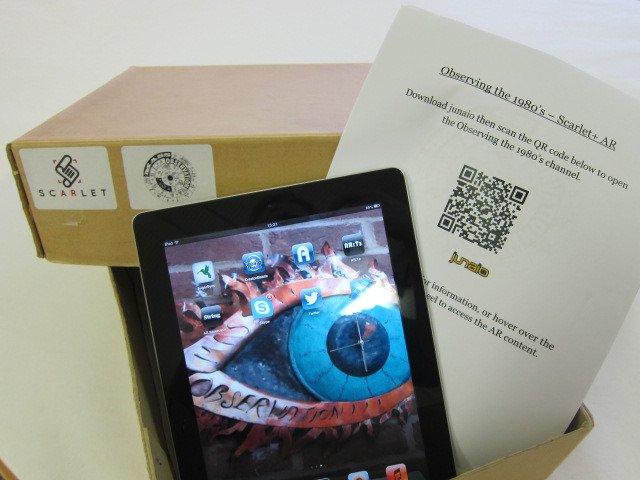
Figure 6: Example materials for the AR session using the Voices In Your Pocket app.
© Special Collections, University of Sussex
From the project team’s experience of talking about and demonstrating AR with colleagues, a fairly high level of enthusiasm was expected. Unfortunately this was not the case. Most of the students were hesitant about even picking up the iPads, commenting that they were not used to ‘being given toys’. It was difficult to gauge the level of interest in the material itself as the group was not forthcoming with their comments [14].
Lessons learned from the experience include:
- set defined questions for the students to answer during the session – perhaps with a written form for those who do not wish to contribute verbally;
- do not assume a certain level of knowledge and confidence with new technology or devices – provide clear step-by-step instructions;
- and ensure that AR applications are underpinned with a clear pedagogy.
AR in a University Museum Context: The Crafts Study Centre
The Crafts Study Centre is a university museum that holds a collection of outstanding 20th-century and contemporary crafts [7]. Its collecting policy is based on quality and innovation. In terms of its audiences, it looks in several directions: inwards towards the staff and students of its hosting organisation, University for the Creative Arts (UCA), and outwards to an international academic community. For example, the archives of crafts practitioners such as the renowned 20th-century potter, etcher, writer and protagonist for the crafts, Bernard Leach, attracts readers from Japan, North America and Australia.
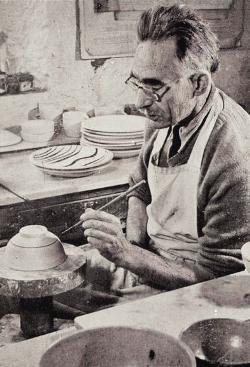
Figure 7: Portrait photograph of Bernard Leach, 1946.
© Crafts Study Centre, University for the Creative Arts
The Centre also looks outwards in another direction, that of a wider, albeit specialist public whose interests lie in the subject areas represented in its historic and contemporary collections: calligraphy; wood and furniture; ceramics; and printed and woven textiles. It has two public galleries and an annual rolling programme of exhibitions. In addition to staging themed exhibitions which display the Centre’s permanent collections, it shows the work of established contemporary artists whose work pushes the boundary of craft practices, across a wider range of subject disciplines.
The challenge and remit set by Mimas was to embed an AR application within the pedagogical practices of our institution and to establish a meeting point between curatorial, teaching, library and technical staff. The SCARLET+ project has required UCA to build awareness and acceptance of a technology which is relatively new to the cultural sector. The aim is that this cultural change at an institutional level will increase the students’ use of the Crafts Study Centre collections, bring us closer to the University’s teaching practices, and through new ways of accessing knowledge, enrich the student experience. In time and depending on resources, the Centre also plans to extend this experience to the museum visitor; for example AR applications have the potential to support the interpretation of objects displayed in an exhibition.
The SCARLET+ project has been an opportunity to use augmented reality as a way to encourage engagement with the collections. This has been one of the differences between the Crafts Study Centre and other uses of AR by Special Collections which have looked at how to make fragile items more accessible without physical access to the objects. From its inception the Crafts Study Centre has encouraged handling of the collections, and, as a Research Centre and specialist university museum, it also has a remit to facilitate and support research both with the University’s own staff and students, and beyond.
The approach at the Crafts Study Centre has been three-stranded: to engage with staff across the University throughout the project; to identify a lead academic and ensure that the focus of technical development work is based upon learning and teaching; and to use and understand AR technology with the support of Mimas at The University of Manchester.
What Is AR? The Crafts Study Centre Perspective
First sight of AR in action is generally very impressive and one of the most exciting aspects of working on the project has been the newness and potential of the technology in education. This has been tempered with the reality of working with technology in education - developing augmented reality applications requires FTP (File Transfer Protocol) access to a Web server from a computer as well as simultaneous access to a compatible device and a strong Wi-Fi connection in order to test the application [15].

Figure 8: The essentials for technical development (excluding content & learning objectives).
© Crafts Study Centre, University for the Creative Arts
In addition to all the parts of the technology which can fail, there is also the issue of finding ways to communicate the new technology to users to enable them to engage with it. None of the technical development work carried out would have been possible without the training and support provided by Mimas.
Engaging with Staff across UCA
Jean Vacher, Institutional Lead on the SCARLET+ project and Curator of the Crafts Study Centre, began the project by setting up meetings with a variety of staff across the University. This included representatives from: the Visual Arts Data Service Research Centre [16] and host of the Crafts Study Centre’s collections online [17]; the University’s newly established Digitisation Unit; the University Archivist; Head of Collections in the Library and Student Services Department; academics from the School of Crafts, Visual Arts and Design and the School of Media and Culture; Professor of Ceramics at the Crafts Study Centre; a learning technologist; and the Animation Research Centre. These conversations were followed up by Marie-Therese Gramstadt, when she joined the project team in September 2012 as an educational technologist; the IT Department was also contacted about the project.
Initially it was a challenge to talk about AR without a tangible example from the Crafts Study Centre; however examples from the Museum of London’s Streetmuseum application [18] and the original SCARLET Project certainly helped. Also following the Mimas technical workshop in October 2012 both project partners’ understanding of AR was growing; for the educational technologist at the Crafts Study Centre this was partly about understanding the new terminology used in developing AR, terms such as pattern or tracking image, and call-back URL and which are contained in a glossary of terms [19].
The contacts across the University were kept up to date about the project’s progress and invited to contribute to the SCARLET+ workshop hosted at the Farnham campus in December 2012. This was an opportunity for colleagues to learn more about AR from the Mimas team, to discuss its implications for their own areas of work and to view and feedback on the first iteration of the Crafts Study Centre app.
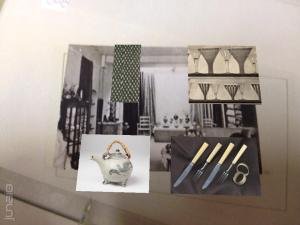
Figure 9: AR content appears on top of an image of the interior of The Little Gallery, set in its archival box context. © Crafts Study Centre, University for the Creative Arts. Photo: Matt Ramirez
Feedback received on the day included:
What was most useful? To see how material culture studies can take this technology further in this type of institution to contrast with a university classroom setting.
Very exciting to see demo and explanation of thinking behind CSC use of Augmented Reality – set my brain thinking in several directions about the applications to my own work. [20]
Pedagogy before Technology
In keeping with the overall SCARLET+ Project aims of integrating AR within the institution, the Crafts Study Centre application has been developed with a lead academic - Adrian Bland, Contextual Studies Co-ordinator, School of Media and Culture. The application was designed to be tested with second-year students as part of the Contextual Studies module; because the students come from a variety of different degree courses, it was important that the content presented would also be wide-ranging, covering ceramics, metalwork, jewellery, glass and textiles. The application, a work in progress, aimed to address the following three objectives:
- to present the AR technology as a contextual framework in its own right;
- to showcase four types of content (ceramics, metalwork and jewellery, glass, textiles) which students can themselves critically evaluate and thereby use to position their own practice;
- and to focus on the role of the Crafts Study Centre as a resource for research and making this appear more accessible to students who may not consider visiting a museum or gallery [15].
Following useful feedback on the application at the AR workshop in December, at the time of writing we are now looking forward to testing the application with students before honing and developing it further.
Conclusion
In conclusion, the two SCARLET+ projects have built on and taken the SCARLET Project in new and exciting directions, and have proved to be a very valuable learning experience for all stakeholders: Special Collections at the University of Sussex, Crafts Study Centre at the University for the Creative Arts, and the Mimas team at The University of Manchester. Although the two case studies were necessarily small-scale, due to funding and time constraints, both have succeeded in showcasing unique holdings at their institutions. Each of these projects also created their own implementation which highlighted particular features of the source objects. For Sussex this was the notion of voices, framing and enhancing the thousands of anonymous voices captured in the Mass Observation records themselves. Meanwhile the Crafts Study Centre application demonstrated the spatial possibilities of the technology by showcasing key items from the Craft Study Centre’s collections that could have been, and in some case were, sold in The Little Gallery - a key historic site for British 20th-century crafts and an innovative model for selling crafts. Building on the lessons learned from the Manchester SCARLET project, these unique AR applications have already shown us new directions to explore in further iterations of the SCARLET toolkit and AR technology. Sharing expertise was always at the heart of both the SCARLET and SCARLET+ projects, and the team hope that others will now be inspired by the possibilities of AR in education.
References
- 2011 HORIZON report, section on augmented reality
http://wp.nmc.org/horizon2011/sections/augmented-reality/ - Mimas http://mimas.ac.uk/
- SCARLET team are joint second in learning and teaching awards, 13 September 2012
http://teamscarlet.wordpress.com/2012/09/13/scarlet-team-are-joint-runner-up-in-learning-technology-awards/ - SCARLET Focus Group, 23 November 2011
http://teamscarlet.wordpress.com/2011/11/23/scarlet-focus-group/ - SCARLET+, a new project adding Augmented Reality skills and knowledge to the community, Team SCARLET blog post, 29 May 2012
http://teamscarlet.wordpress.com/2012/05/29/scarlet-a-new-project-adding-augmented-reality-skills-and-knowledge-to-the-community/ - Special Collections at the University of Sussex http://www.sussex.ac.uk/library/specialcollections
- Crafts Study Centre at the University for the Creative Arts http://www.csc.ucreative.ac.uk/
- SCARLET Toolkit http://scarlet.mimas.ac.uk/mediawiki/index.php/Main_Page
- St John Fragment AR content, 25 October 2012
http://teamscarlet.wordpress.com/2012/10/25/st-john-fragment-ar-content/ - Mass Observation Archive http://www.massobs.org.uk
- Observing the 1980s, Jisc-funded project http://blogs.sussex.ac.uk/observingthe80s/
- The Mass Observation Project (1981-) http://www.massobs.org.uk/mass_observation_project.html
- SCARLET+, adding Augmented Reality to the University of Sussex’s Toolkit, Team SCARLET blog post, 31 July 2012
http://teamscarlet.wordpress.com/2012/07/31/scarlet-adding-augmented-reality-to-the-university-of-sussexs-toolkit/ - SCARLET+ ‘What has it got in its Pockets-es?’ – introducing Augmented Reality to students without getting them lost in the dark, Team SCARLET blog post, 13 December 2012
http://teamscarlet.wordpress.com/2012/12/13/scarlet-what-has-it-got-in-its-pockets-es-introducing-augmented-reality-to-students-without-getting-them-lost-in-the-dark/ - Triangles and teapots: AR technology development, Team SCARLET blog post, 14 December 2012 http://teamscarlet.wordpress.com/2012/12/14/triangles-and-teapots-ar-technology-development/
- Visual Arts Data Service Research Centre http://vads.ac.uk/
- Crafts Study Centre digital collections online at VADS http://vads.ac.uk/collections/CSC.html
- Museum of London’s Streetmuseum AR application
http://www.museumoflondon.org.uk/Streetmuseum.htm - Portal to another world, Team SCARLET blog post, 15 November 2012
http://teamscarlet.wordpress.com/2012/11/15/portal-to-another-world/ - Discovering augmented reality at UCA, Team SCARLET blog post, 14 December 2012
http://teamscarlet.wordpress.com/2012/12/14/discovering-augmented-reality-at-uca/
Author Details
Email: laura.skilton@manchester.ac.uk
Laura Skilton develops and manages technology-enhanced projects and services to support and improve learning and teaching. This includes Hairdressing Training, Jorum and Augmented Reality projects such as SCARLET (Special Collections using Augmented Reality to Enhance Learning and Teaching). As Jorum Business Development Manager, Laura supports organisations and institutions to exploit Jorum’s technical infrastructure and expertise in finding and sharing Open Educational Resources (OER), using co-funding to develop ‘windows’ onto their resources via Jorum. She also works with a large charity, Cats Protection, on their use of e-learning to train their 7,000 volunteers, including OER development.
Email: matthew.ramirez@manchester.ac.uk
Matt Ramirez is currently working on the technical development and support of the Jisc-funded SCARLET+ Augmented Reality Project, this follows on from his involvement in the award-winning SCARLET Project. He is also involved in the delivery and technical support of a number of teaching and learning projects including Hairdressing Training and Jorum. Matt’s role is also concerned with the research and development of new technologies such as various iBook/mobile/multimedia development projects with the Manchester Medical School which aim to improve the student experience by embracing innovative learning methods.
Email: guyda.armstrong@manchester.ac.uk
Guyda Armstrong is Senior Lecturer in Italian Studies at the University of Manchester, specialising in medieval Italian literature with an interdisciplinary approach which combines textual and material studies, with translation and the digital humanities.
She has a long-standing research interest in the digital humanities and their application to literary studies. She is the Principal Investigator for the Manchester Digital Dante project, a British Academy Project which digitized culturally significant editions of Dante’s Divine Comedy held in the University of Manchester’s Special Collections.
She was also lead academic on the award-winning JISC-funded SCARLET Project (Special Collections using Augmented Reality to Enhance Learning and Teaching), which developed a mobile app to allow students to integrate iconic material from the University’s special collections into their learning and teaching.
Email: r.lock@sussex.ac.uk
Rose Lock is the Special Collections Supervisor at the University of Sussex Library. She is also the Project Co-ordinator for SCARLET+ at Sussex. She works with the extensive 20th Century literary and socio-historical collections held by the Library which include the Mass Observation Archive, and the personal papers of Virginia Woolf and Rudyard Kipling, amongst others. More recently she has been heavily involved in the planning and preparation of the move of the collections to a new resource centre, The Keep, which will hold the collections of East Sussex, Brighton and Hove and the University of Sussex.
Email: jvacher@ucreative.ac.uk
Jean Vacher’s main area of personal research has been the history, culture and identity of the Balkan people in the early part of the 20th century, viewed through their textiles. Key research methods have used material culture held in public collections including that of the Crafts Study Centre (CSC), the archives of such bodies as the Royal Institute of Anthropology and other primary and secondary sources relating to this area of interest. She would like to extend these methods to other cultures where these have been represented in the CSC’s practitioner’s reference collections.
Email: mtg@vads.ac.uk
Web site: http://www.research.ucreative.ac.uk/profile/60
Marie-Therese Gramstadt is currently managing the KAPTUR Project (Jisc, 2011-13) working with Goldsmiths, University of London, The Glasgow School of Art, University of the Arts London and University for the Creative Arts, to improve the management of arts research data. She is also a Researcher and Digital Cataloguer for the Zandra Rhodes Digital Study Archive (Jisc, 2011-13), making use of her MA in the History of Dress (Courtauld Institute of Art). Marie-Therese has recently re-joined the Crafts Study Centre to work on the SCARLET+ Project using augmented reality with the Muriel Rose Archive (Jisc, 2012-13). Previous projects include: Kultivate (Jisc, 2010-11), eNova (Jisc, 2011) and three Learning and Teaching Research grants (2010, 2010-11, 2011-12).

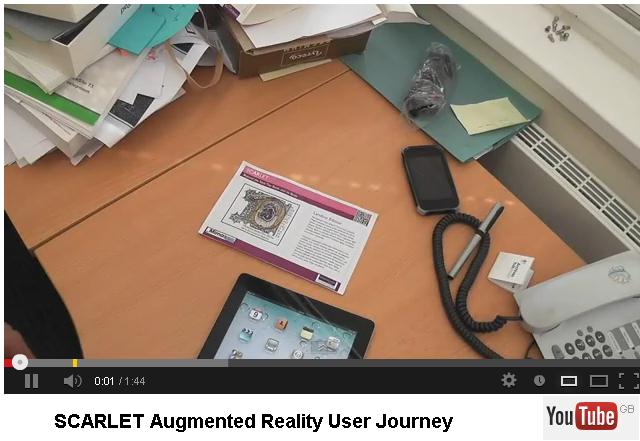
![Figure 3: AR content shown over an image of the papyri fragment of the Gospel of St. John [9]. © Mimas, University of Manchester. Photo: Marie-Therese Gramstadt Figure 3: AR content shown over an image of the papyri fragment of the Gospel of St. John [9]. © Mimas, University of Manchester. Photo: Marie-Therese Gramstadt](/images/issue71-skilton-et-al/figure3-gospel-of-st-john.jpg)
